|
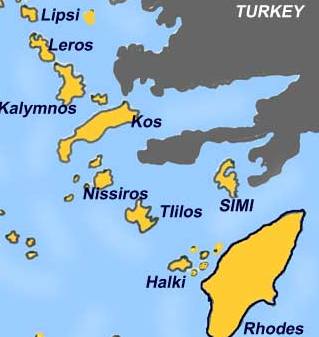 ITINERARY ITINERARY
Day 01 Rhodes
Transfer to the
boat. Depending on the time of the transfer we can include lunch (
optional not included in the price)
If the transfer is early in the morning, Sail around Rhodes Island.
Dinner on board. Overnight at the harbor of Rhodes. For more info on
Rhodes click here

Day 02 Chalki
Depart Rhodes after
breakfast.
33 sea miles takes about 5 hours.
Arrive in Halki at lunch time. Before we dock on the harbor we will have
time for swimming.
Lunch on board Grand Acar. Dinner is not included since we assume the
clients might like to have dinner on the island.
The island is very
small
and extremely
picturesque. Every thing you want to see on the island will be 10
minutes walk from the dock.
Khalki ( Chalki ), is a small mountainous island, of
about 400 inhabitants.. Its name most probably reflects the copper (chalkos
in Greek) once mined there. It has only one settlement. Emborio or
Nimborio, a little harbor town consisting of 2 and 3-story Venetian
style renovated mansions, overshadowed by a Byzantine bell tower and a
dramatic backdrop of rugged mountains guarded by 3 ruined windmills. For
more info on Chalki please click here

Day 03 Tilos
Depart after
breakfast. Swim stop before we get to Tilos Island.
Tilos is an Aegean island with nineteen beaches, twelve
mountains, seven medieval castles, a Byzantine monastery and two hundred
churches, a cave full of natural discoveries, a village that is a
declared cultural monument, a hundred bird species, hundreds of wild
flowers and herbs, and five hundred residents. Sail to Tilos - Greece It
takes approximately 3 hours - 20 sea miles.Lunch
on board Grand Acar. Dinner not included. On this Island you might want
to rent a car and drive to the tiny village at the top of the mountain.
the village has a very unique museum: Elephant museum. For more info
please click here

Day 04 Nisyros
Depart after
breakfast. Swim stop before we get to the Island of Nissiros.Nisyros
is a small island in the Dodecanese complex, between Kos and Tilos. It
is a quiet place, far from the tourist current other Greek islands have,
that fascinates and charms visitors with its strong colorful character,
the dark brown of its volcanic earth, the white of its houses and the
deep blue of its sea. Nothing disturbs the silence of the island, which
gives it a mysterious charm that remains with visitors who almost always
fall in love with Nisyros and cherish its memories One of the natural
attractions of Nisyros island is the volcano, on its central side, near
the village of Nikia, on the plateau of Lakki. Sail to Nisyros - Greece
5 hours sailing lunch on board. 
Day 05 Simi
Simi- Greece 30 sea miles 4-5 hour sailing. Lunch on
board. Simi is noted for peace and tranquility rather than beaches,
which are in short supply. The neo-classical mansions that hang off the
hills around the main port are a reminder of the rich pickings once
enjoyed by the inhabitants. Since there are so many wonderful
restaurants, we have not included dinner on board.
Day 06 Pedi
After breakfast
leisure time for the clients to explore the wonderful Island. They can
rent a car or rent a motor bike to see this wonderful Island. In the
afternoon at 04:00 PM leave Simi bay and sail to Pedi Bay of the same
Island. Dinner on board.

Day 07 Rhodes
Sail back to Rhodes.
Lunch and dinner on
board Grand Acar
Day 08
After breakfast
depart for transfer to the airport/hotel.
The
net price
Includes:
Meals :
Please check the meal list
below
Tea-
time snack and tea/coffee
Harbor
charges, dues and all official fees
Water
served with meals
The price does
not include:
Meal Chart
|
DAY |
BREAKFAST |
LUNCH |
DINNER |
|
Day 01
Rhodes |
Not
included |
Not
included |
Included |
|
Day 02
Halki |
Included |
Included |
Not included |
|
Day 03
Tilos |
Included |
Included |
Not included |
|
Day 04
Nisyros |
Included |
Included |
Not included |
|
Day 05
Simi |
Included |
Included |
Not included |
|
Day 06
Pedi |
Included |
Included |
Included |
|
Day 07
Rhodes |
Included |
Included |
Included |
|
Day 08
Departure |
Included |
Not Included |
Not included |
Rhodes Island
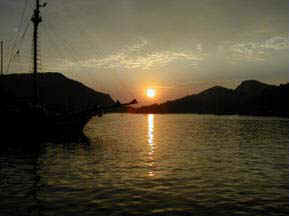 Rhodes
is the largest of the Dodecanese islands and one of the largest in the
Aegean sea. It is situated approximately 17,7 km from the coasts of
Turkey. The population is about 130.000 persons , of which approximately
60-70.000 reside in the city of Rhodes. Rhodes called from its local
people the Rose of the Aegean and deserves its name because is one of
the most beautiful Greek islands. Rhodes has the oldest tourist history
from all the islands of Greece . Rhodes town is divided to the new town
and the old town from the big medieval wall. Rhodes
is the largest of the Dodecanese islands and one of the largest in the
Aegean sea. It is situated approximately 17,7 km from the coasts of
Turkey. The population is about 130.000 persons , of which approximately
60-70.000 reside in the city of Rhodes. Rhodes called from its local
people the Rose of the Aegean and deserves its name because is one of
the most beautiful Greek islands. Rhodes has the oldest tourist history
from all the islands of Greece . Rhodes town is divided to the new town
and the old town from the big medieval wall.
The beauty of Rhodes town is the old town with the medieval castles
,houses and streets. At the port the visitor will find Mandraki with its
circular Market and the Cafes at the seafront ,further on are the Art
Deco buildings of the Metropolis from the times of the Italian
occupation. At the entrance of the port are the famous two columns with
the two Deers at the place where supposed to be the colossus of Rhodes
.The ancient city of Lindos is another of the main Attractions of the
island.
HISTORY OF RHODES
Rhodes was inhabited at the
Neolithic era. In 322BC, Rhodes was joined with the empire of Alexander
the Great. After his death , Rhodes maintained in close trade with the
kingdom of Ptolemy's in Egypt. In 164BC, Rhodes signed a treaty with
Rome. At the first century of our era,St Paul visited the island.
Between 1307 and 1522, the island was the seat of the order of Knights
of St John of Jerusalem. The Knights occupied Rhodes in 1307 and
completed the conquest in 1310 . They strengthened the city, leaving the
Great current walls. In the low part of Rhodes, they built the palace of
the Great Master . The island was a first seat in 1480, before falling
to the hands from the Turks from Soleiman the Magnificent in 1522, after
a five month siege. In 1912, Italy seized the island which belonged to
the Turks then. The island reunited with Greece in 1948.The Colossus of
Rhodes
After defeating Demetrius Poliorcetes in 305 BC, the citizens of Rhodes
used their booty to erect a thank offering to their divine patron
Helios. Chares of Lindos, a pupil of Lysippus, built (292-280 BC) a
bronze statue of the nude young god wearing a sun-ray crown and looking
out to sea. Many stories exaggerate the size of the statue; it must,
however, have been approximately 36 m (120 ft) high on a base of white
marble 6-7.5 m (20-25 ft) high and thus larger than any other statue. It
stood beside, not over, the harbor. Although reinforced with stone and
iron, the Colossus broke at the knees and fell in an earthquake 60 years
later. It remained a wonder until the Arab invasion (AD 653), when it
was broken up and sold for scrap metal. Nothing of it remains except
very dubious copie.
SITES TO VISIT IN RHODES
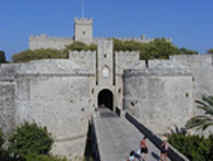 The
Medieval City The
Medieval City
During the 14th and 15th centuries the Knights of the
Order of St. John extended the Byzantine city and reinforced its
fortifications creating the medieval town of Rhodes. Of note is the
architecture in the gothic style developed in Provence at the Papal
Court of Avignon (1309-1424) with which the Knights maintained close
ties.
Eleven gates provided access to the city which is divided into two
parts: The Collachium, where the Knights resided - the most impressive
buildings from that time are located here: the Grand Master's Palace,
the Infirmary and the Langues -
and the Burgo, the main town.
The Old Town, as the locals call it, is today one of the best preserved
fortified medieval towns and has been listed by UNESCO and a world
cultural heritage monument. Walking down its paved streets, admiring the
imposing Knightly buildings, the walls and their dry moat and the
bastions, the Byzantine churches and the mosques, the squares, gardens
and courtyards of houses, the visitor feels that time has stopped while
at the same time discovering that this unique town is still living, full
of surprises and just asking you to explore it.
The Knights' Street
(Odhos Ippoton) is 200 m long and 6 m wide. It was the main official
street connecting the religious and political centre of the fortress, in
other words the Catholic Cathedral (Panaghia Kastrou) and the Palace of
the Grand Master. Along its length are the most important public and
private buildings erected by the Knights. Here, with few exceptions, is
the accommodation for the Knights, the "Langues", the national divisions
of the Order of the Knights of St. John. The street is inclined and
unusually for a medieval city completely straight. That is one
indication that it was first marked out in antiquity. This was retained
by the Knights precisely because the strict linear layout suited them
and the new political importance they attached to it.
Visit the
Clock Tower
built in 1851 which was once used as lookout post. It has a small
collection of archaeological finds discovered there. The view of the Old
Town from the tower is breathtaking.
Panaghia Bourgou is a late gothic church dating from the 14th century.
It was bombed during World War II and today the three apses of the
sanctuary are what remain.
Sokratous St. ends in Ippokratous Square. It is the main commercial
street in the Old Town. Around the square with its large fountain are
many bars, restaurants and nightclubs.
Of the many impressive mosques in the Old Town the Suleyman Mosque is
truly noteworthy. The present-day building was constructed in the 19th
century on the site of an older one which tradition says was erected by
the town's conqueror Suleyman the Magnificent. Note the intricate marble
entrance which comes from a grave monument from the time of the knights.
In Dorieon Sq. lies Retzet Pasha Mosque.
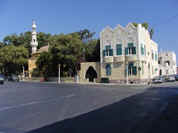 New
Town New
Town
The
Temple of Aphrodite
from the 3rd century BC. Its ruins were unearthed in the heart of the
new town between Mandraki and Akandia Port in Symi Square.
Murat Reis Mosque with its elegant minaret lies near the Prefectural
Building. It is built on the site of Aghios Antonios Church next to the
Knight's Cemetery. The Turkish cemetery contains the tombs of exiled
Turks, an admiral of Suleyman II's fleet in a round mausoleum and a poet
banished by the Sultan for his sarcastic poetry. In the square around
the mosque the ruins of the ancient walls have been found together with
inscribed stone balls marked with their weight. They begin at 5 mnes and
reach 10 talents (2 to 261 kilos approximately). From the type of
letters the balls have been dated to the famed siege by Dimitris
Poliorcetes. Aghios Nikolaos lighthouse is a fortress at the end of the
jetty with the same name where the deer statutes stand at the entrance
to the port welcoming visitors to the island.
At the other end are three windmills. The first houses the offices of
the Army Hydrographical Service where maritime maps can be purchased.
The second from the 15th century operates as a museum. One can see the
grinding mechanism while the third houses a travel agency.
Aghios Stefanos Hill also known as Monte Smith after an English admiral
of Napoleon who called at the island in 1802. In the well laid out and
verdant archaeological park are the surviving remains of a 3rd century
BC Stadium where the Alies Games were held, the largest celebration for
the Ancient Rhodians in honour of the god Helios.
Next to the stadium a small, marble open-air theatre has been restored
and is used for musical performances just like in antiquity.
At the peak of the hill is the temple of Apollo Pythia, protector of the
city. From here the view over the town and the sea is panoramic and the
sunset enchanting.
The tombs of St. John are in the central part of the extensive Rhodian
necropolis. Important monuments are the large corner tomb complex with
domed graves, the group of domed graves crowned by a monument with
triglyphs and metopes and the tomb carved into the rock with a
monumental gateway. Of most interest is the underground quarry into
whose tunnels grave chambers were dug.
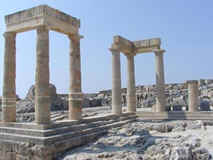 LINDOS LINDOS
  Lindos
(46 km from Rhodes town) Lindos
(46 km from Rhodes town)
The listed village of Lindos has preserved its architectural uniqueness
as well as its traditional decoration. White, boxy houses with flat
roofs, imposing entrances leading into courtyards filled with flowers
accessed along pebbled streets are situated around a sheltered port and
lead up to the acropolis. The climb is via picturesque narrow streets on
foot or on Lindos 'taxi', donkeys.
The acropolis of Lindos is built on a precipitous rock soaring 116 m and
dominating the village. It is a real balcony with a view over the sea.
The monuments there are evidence of the power and wealth of Lindos over
the ages.
Chalki Island

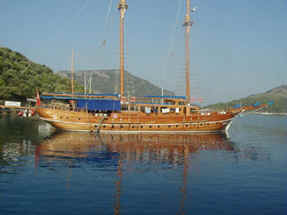  Khalki
( Chalki ), is
a small mountainous island, of about 400 inhabitants, that
covers a surface area of 28km. Its name most probably
reflects the copper (chalkos in greek) once mined there. It
has ony one settlement. Emborio or Nimborio,a little harbour
town consisting of 2 and 3-story Venetian style renovated
mansions, overshadowed by a Byzantine bell tower and a
dramatic backdrop of rugged mountains guarded by 3 ruined
windmills (Vassilakio, Aggelakio and Andrikakio). On the
main road leading to and from the harbour you can see the
bust of Alexandros Diakos, the first officer to fall
defending the ideals of democracy and freedom in the
Dodecanese islands during WWII. Do not miss the church of
St. Nicholas, built in 1861, with its magnificent bell tower
whose base leans over an arch made of ancien marbles taken
from a temple dedicated to Apollo, as well as the
ecclesiastical museum that exists there. Furthermore, in
Emborio you can see the clock tower - a donation of the
expatriate Chalkian community - that stands before the Town
Hall, and the building of Hiona Vouvali, once used for
storing sponge supplies. Ten minutes away from Emborio is
Pondamos beach, a sandy length of coastline framing crystal
clear waters. But there is more undiscovered shoreline, as
Chalki is surrounded by a string of pure white beaches (some
within walking distance and other best reached by boat).
Hire a little motor boat to take you to the beaches of Yiali,
Trachia, Kania or Areta and to the islet of Alimia. Khalki
( Chalki ), is
a small mountainous island, of about 400 inhabitants, that
covers a surface area of 28km. Its name most probably
reflects the copper (chalkos in greek) once mined there. It
has ony one settlement. Emborio or Nimborio,a little harbour
town consisting of 2 and 3-story Venetian style renovated
mansions, overshadowed by a Byzantine bell tower and a
dramatic backdrop of rugged mountains guarded by 3 ruined
windmills (Vassilakio, Aggelakio and Andrikakio). On the
main road leading to and from the harbour you can see the
bust of Alexandros Diakos, the first officer to fall
defending the ideals of democracy and freedom in the
Dodecanese islands during WWII. Do not miss the church of
St. Nicholas, built in 1861, with its magnificent bell tower
whose base leans over an arch made of ancien marbles taken
from a temple dedicated to Apollo, as well as the
ecclesiastical museum that exists there. Furthermore, in
Emborio you can see the clock tower - a donation of the
expatriate Chalkian community - that stands before the Town
Hall, and the building of Hiona Vouvali, once used for
storing sponge supplies. Ten minutes away from Emborio is
Pondamos beach, a sandy length of coastline framing crystal
clear waters. But there is more undiscovered shoreline, as
Chalki is surrounded by a string of pure white beaches (some
within walking distance and other best reached by boat).
Hire a little motor boat to take you to the beaches of Yiali,
Trachia, Kania or Areta and to the islet of Alimia.
  Deeper
into the mainland, a ruined crusade castle, perched on a
hill, guards the remains of the old capital, Chorio, now
deserted. The walk to the castle is wonderful and the ruins
are untouched. The Chalkian castle has a history of more
than two thousand years. St. John's Knights constructed the
main building on the remains of an ancient acropolis in the
14th or the 15th century. Walking up the path to the
castle's entrance visitors come across ancient marbles,
foundations of temples, but also the remains of walls of the
Hellenistic/classical perod, Byzantine churches and bigger
or smaller ancient Greek and Byzantine cisterns. It is a
path of history. The views from the unguarde ramparts, over
the town towards Rhodes, or out towards distant Karpathos,
are sensational. At the NE of the castle, admire the church
of St. Nicholas and its magnificent frescoes. Chalki is an
ideal island for walkers. Take long walks to discver the
approximately 360 country chapels, most of them very old and
now ruined. The hospitable Chalkians will be happy to
suggest you paths and trails to discover the island's
unrevealed beauty. You will enjoy Chalki's hospitality at
its best, however, if you are lucky enough to be there
during its festivities. The Deeper
into the mainland, a ruined crusade castle, perched on a
hill, guards the remains of the old capital, Chorio, now
deserted. The walk to the castle is wonderful and the ruins
are untouched. The Chalkian castle has a history of more
than two thousand years. St. John's Knights constructed the
main building on the remains of an ancient acropolis in the
14th or the 15th century. Walking up the path to the
castle's entrance visitors come across ancient marbles,
foundations of temples, but also the remains of walls of the
Hellenistic/classical perod, Byzantine churches and bigger
or smaller ancient Greek and Byzantine cisterns. It is a
path of history. The views from the unguarde ramparts, over
the town towards Rhodes, or out towards distant Karpathos,
are sensational. At the NE of the castle, admire the church
of St. Nicholas and its magnificent frescoes. Chalki is an
ideal island for walkers. Take long walks to discver the
approximately 360 country chapels, most of them very old and
now ruined. The hospitable Chalkians will be happy to
suggest you paths and trails to discover the island's
unrevealed beauty. You will enjoy Chalki's hospitality at
its best, however, if you are lucky enough to be there
during its festivities. The
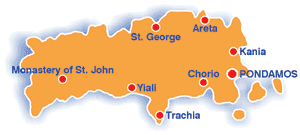 whole
island celebrates with a memorable passion, and everyone is
more than welcome to join in. Every 29th of August, the
island's biggest feast, held at the monastery of Ai Giannis,
is honored by Chalkians living throughout the world coming
back this particular day to celebrate. Lying just a few
miles off the island of Rhodes, this tiny island has
completely escaped the busyness of its larger neighbour.
Once a self-sufficient island made rich by sponge diving,
Chalki is now a quiet island promising relaxing, though
interesting holidays... whole
island celebrates with a memorable passion, and everyone is
more than welcome to join in. Every 29th of August, the
island's biggest feast, held at the monastery of Ai Giannis,
is honored by Chalkians living throughout the world coming
back this particular day to celebrate. Lying just a few
miles off the island of Rhodes, this tiny island has
completely escaped the busyness of its larger neighbour.
Once a self-sufficient island made rich by sponge diving,
Chalki is now a quiet island promising relaxing, though
interesting holidays...
HISTORY OF CHALKI
The island supported a much larger population
but following emigration in the mid twentieth century Chorio
was almost completely abandoned. A ruined medieval castle of
the Knights of St. John overlooks the old town and the
chapel contains some of the original frescoes.
 Chalki
possibly got its name from the copper (in Greek chalkos)
workshops that were there in ancient times. The Titans were
according to Greek mythology the first inhabitants of all
the surrounding islands. The Pelasgians lived here for a
long time, leaving several constructions behind, before they
were succeeded by the Carians, the Dorians and later the
Phoenicians. Aretanassa, the illustrious queen of Halki
lived here once, before being exiled in Karpathos where she
committed suicide after her husband's death. Remains of
three temples of the god Apollo are preseved at the location
of Pefkia, today's Nimborio (along the coastline). The god
was worshipped here with exceptional honours. During the
flourishing period of the Athenian state, Chalki regularly
paid the alliance taxes. In the 7th century it is concered
by the Arabs, until 825 when it is liberated. Venetians and
Genovians arrived on the island in 1204 and repaired the
ancient acropolis, building at the same time a fortress on
the island of Alimia. In 1523 Chalki was conquered by the
Turks. It takes part in the 1821 revolution, it is conquered
by the Italians in 1912 and finally is annexed to Greece
along with the rest of the Dodecanese. Chalki
possibly got its name from the copper (in Greek chalkos)
workshops that were there in ancient times. The Titans were
according to Greek mythology the first inhabitants of all
the surrounding islands. The Pelasgians lived here for a
long time, leaving several constructions behind, before they
were succeeded by the Carians, the Dorians and later the
Phoenicians. Aretanassa, the illustrious queen of Halki
lived here once, before being exiled in Karpathos where she
committed suicide after her husband's death. Remains of
three temples of the god Apollo are preseved at the location
of Pefkia, today's Nimborio (along the coastline). The god
was worshipped here with exceptional honours. During the
flourishing period of the Athenian state, Chalki regularly
paid the alliance taxes. In the 7th century it is concered
by the Arabs, until 825 when it is liberated. Venetians and
Genovians arrived on the island in 1204 and repaired the
ancient acropolis, building at the same time a fortress on
the island of Alimia. In 1523 Chalki was conquered by the
Turks. It takes part in the 1821 revolution, it is conquered
by the Italians in 1912 and finally is annexed to Greece
along with the rest of the Dodecanese.
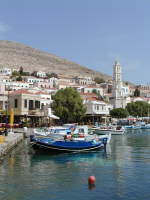 SITES
TO VISIT IN CHALKI SITES
TO VISIT IN CHALKI
Ancient crusader castle, Church of St.
Nicholas
Monastery of Stavros
Old monastery of Taxiarchis Michail Panormitis
Small chapel of Ai Giannis
Phoeniki with the half ruined monastery of St. Zaharias
Pefkia with Apollo's temple
The islets of Alimia and Krevati
Tilos Island
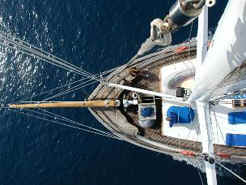   Tilos is
an Aegean island with nineteen beaches, twelve mountains,
seven medieval castles, a Byzantine monastery and two
hundred churches, a cave full of natural discoveries, a
village that is a declared cultural monument, a hundred bird
species, hundreds of wild flowers and herbs, and five
hundred residents. Livadia is the island’s main port Livadia
was established around 1930 as a village although it had
existed as a harbour before that. Most of the buildings are
modern mixed with a few traditional ones. Livadia has a
lovely horseshoe bay which is excellent for swimming and
snorkelling, there is also shade along the beach beneath the
Tamarisk trees. These trees were originally planted as a
windbreak to protect the crops grown in the very fertile
soil along the front. The North winds are so dry they can
‘burn’ crops. Above the village is the remains of a 15th
century castle – Agriosikia and in the valleys below the old
monastery Politissa Tilos is
an Aegean island with nineteen beaches, twelve mountains,
seven medieval castles, a Byzantine monastery and two
hundred churches, a cave full of natural discoveries, a
village that is a declared cultural monument, a hundred bird
species, hundreds of wild flowers and herbs, and five
hundred residents. Livadia is the island’s main port Livadia
was established around 1930 as a village although it had
existed as a harbour before that. Most of the buildings are
modern mixed with a few traditional ones. Livadia has a
lovely horseshoe bay which is excellent for swimming and
snorkelling, there is also shade along the beach beneath the
Tamarisk trees. These trees were originally planted as a
windbreak to protect the crops grown in the very fertile
soil along the front. The North winds are so dry they can
‘burn’ crops. Above the village is the remains of a 15th
century castle – Agriosikia and in the valleys below the old
monastery Politissa
Megalo Horio
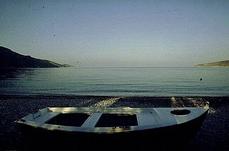 The
capital of the island with just 180 full-time residents.
Megalo Horio (Big Village) is much older and more
traditional Greek village with winding alleyways and
traditional buildings. There is one road that runs past the
village but the majority is inaccessible by car. There are
some beautiful churches here – the Church of Archangel
Michael (Taxiarchis) opposite the Island Council Offices and
Panagia on top of the village. On the summit above the
village is the most complete of the seven Crusader castles
on the island. It’s a steep climb up with no shade but
stunning views from the top. Also here is the Elephant
Museum – where finds from the Harkadio Cave are displayed –
if the museum is closed, ask at the council offices (go up
the stairs to the left of the museum). Vicky the guide is
usually around to fill you in on all the necessary details!
Also in Megalo Horio is another pharmacy/doctor’s surgery. The
capital of the island with just 180 full-time residents.
Megalo Horio (Big Village) is much older and more
traditional Greek village with winding alleyways and
traditional buildings. There is one road that runs past the
village but the majority is inaccessible by car. There are
some beautiful churches here – the Church of Archangel
Michael (Taxiarchis) opposite the Island Council Offices and
Panagia on top of the village. On the summit above the
village is the most complete of the seven Crusader castles
on the island. It’s a steep climb up with no shade but
stunning views from the top. Also here is the Elephant
Museum – where finds from the Harkadio Cave are displayed –
if the museum is closed, ask at the council offices (go up
the stairs to the left of the museum). Vicky the guide is
usually around to fill you in on all the necessary details!
Also in Megalo Horio is another pharmacy/doctor’s surgery.
Mikro Horio
Mikro Horio was the original capital of the
island and was once home to 1700 people. The village is now
deserted – the residents either emigrated or moved down to
the Livadia to be closer to the developing port. Nowadays
the village is like a time-capsule a witness to a life that
no longer exists. It is very atmospheric
to wander around. The bus does not go to Mikro Horio but it
is not too long a walk.
Harkadio
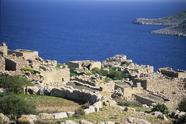 On
the left hand side of the road to Megalo Horio is the
Harkadio Cave where the remains of dwarf elephants were
discovered in 1971. The cave is not open to the public as
excavations are still continuing. However, the view from
outside the cave is wonderful and underneath is a small
amphitheatre which is host to concerts during the summer
months. Stand in the centre to experience the perfect
acoustic! Nearby the entrance, you will see the construction
of the new museum which will eventually contain the finds
made in the cave. Some are presently on display in the small
museum in Megalo Horio but the majority are in Vienna. The
bones of thousands of elephants have been found in the cave
and the discovery was on of the first to establish the
existence of elephants in Europe - it is thought that they
swam here from Africa and the dwarfism developed due to a
gradual decline in the population due to hunting by man. On
the left hand side of the road to Megalo Horio is the
Harkadio Cave where the remains of dwarf elephants were
discovered in 1971. The cave is not open to the public as
excavations are still continuing. However, the view from
outside the cave is wonderful and underneath is a small
amphitheatre which is host to concerts during the summer
months. Stand in the centre to experience the perfect
acoustic! Nearby the entrance, you will see the construction
of the new museum which will eventually contain the finds
made in the cave. Some are presently on display in the small
museum in Megalo Horio but the majority are in Vienna. The
bones of thousands of elephants have been found in the cave
and the discovery was on of the first to establish the
existence of elephants in Europe - it is thought that they
swam here from Africa and the dwarfism developed due to a
gradual decline in the population due to hunting by man.
Nisyros Island
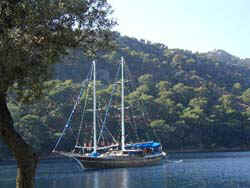  Nisyros
is a small island in the Dodecanese complex, between Kos and
Tilos. It is a quiet place, far from the tourist current
other Greek islands have, that fascinates and charms
visitors with its strong colourful character, the dark brown
of its volcanic earth, the white of its houses and the deep
blue of its sea. Nothing disturbs the silence of the island,
which gives it a mysterious charm that remains with visitors
who almost always fall in love with Nisyros and cherish its
memories One of the natural attractions of Nisyros island is
the volcano, on its central side, near the village of Nikia,
on the plateau of Lakki. It's an active volcano with a large
crater into which one can descend by steps. Entering the
crater, one could easily believe that one was walking on the
moon, were it not for the hot sun that shines above in all
its glory. The crater is layered with a hot surface (not
hot enough to scold, one can easily walk on it but shoes,
preferably mountain boots are most definitely required) and
thick vapours, and is frequently visited by tourists from
the nearby Greek islands.Nisyros also has therapeutic
springs with good curative properties at Loutra, near the
capital.A traditional product of Nisyros is soumada,
a non-alcoholic almond-flavoured drink. The patron saint of
the island is Saint Nikitas. Many Orthodox Christian
churches are found on the island, as well as four
monasteries which are not inhabited by monks today, although
various celebrations take place in them. The largest
monastery is the one of Panagia
Spiliani (Blessed
Virgin Mary of the cave) at Mandraki. It is built beside the
medieval castle erected by the Knights Hospitaller who
conquered the island in 1315. Nisyros
is a small island in the Dodecanese complex, between Kos and
Tilos. It is a quiet place, far from the tourist current
other Greek islands have, that fascinates and charms
visitors with its strong colourful character, the dark brown
of its volcanic earth, the white of its houses and the deep
blue of its sea. Nothing disturbs the silence of the island,
which gives it a mysterious charm that remains with visitors
who almost always fall in love with Nisyros and cherish its
memories One of the natural attractions of Nisyros island is
the volcano, on its central side, near the village of Nikia,
on the plateau of Lakki. It's an active volcano with a large
crater into which one can descend by steps. Entering the
crater, one could easily believe that one was walking on the
moon, were it not for the hot sun that shines above in all
its glory. The crater is layered with a hot surface (not
hot enough to scold, one can easily walk on it but shoes,
preferably mountain boots are most definitely required) and
thick vapours, and is frequently visited by tourists from
the nearby Greek islands.Nisyros also has therapeutic
springs with good curative properties at Loutra, near the
capital.A traditional product of Nisyros is soumada,
a non-alcoholic almond-flavoured drink. The patron saint of
the island is Saint Nikitas. Many Orthodox Christian
churches are found on the island, as well as four
monasteries which are not inhabited by monks today, although
various celebrations take place in them. The largest
monastery is the one of Panagia
Spiliani (Blessed
Virgin Mary of the cave) at Mandraki. It is built beside the
medieval castle erected by the Knights Hospitaller who
conquered the island in 1315.
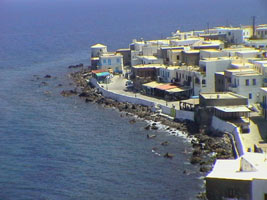 Nisyros
History Nisyros
History
The history of Nisyros is closely linked with
the volcanic eruptions that occurred in the ancient past.
The first known inhabitants of the island were Karrians but
recent evidence has found relics left by people from Kos,
Thessaly and Rhodes during the ancient times of Greek
History. According to the Greek Mythology, Nisyros was was
born by a stone that Poseidon throw to the Giant Polyvoti
during the fight of Gods against the Giants.
The rock was a piece from the island of Kos and that rock
created Nisyros. During the Persian wars Nisyros together
with the islands of Kos and Kalymnos where under the rule of
the small kingdom of Halicarnassus and her queen Artemissia
one of the alliances of Xerxes in his campaign against
Greece.
The history of Nissyros and its growth,
because of its proximity, was linked to that of Rhodes. In
modern times, the development of Nissyros is due to the
investments made by ex-patriots who emigrated after the
Second World War. Up until 1948 when the island unified with
Greece, like all of the Dodecanese, Nisyros was an Italian
colony.
Places to visit on Nisyros
 Mandraki: The
Old Fortress (Paleokastro) with the ruins of the ancient
city lies 4 km southwest. Sections of the fortified walls Mandraki: The
Old Fortress (Paleokastro) with the ruins of the ancient
city lies 4 km southwest. Sections of the fortified walls 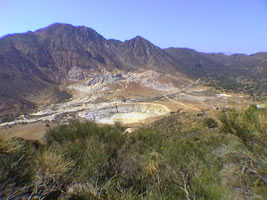 dating
from the 4th century BC and the gateway structure have
survived. They are strongly reminiscent of similar Mycenean
structures. dating
from the 4th century BC and the gateway structure have
survived. They are strongly reminiscent of similar Mycenean
structures.
The ancient cemetery with finds dating from the 7th and 6th
centuries BC and a grave from the 5th century BC.
Fortresses : Mandraki:
Spiliani Fortress dominates the capital and
is thought to have been built by the Knights of the Order of
St. John (1315). The view from this location is unique.
Emborios:
The ruined Venetian Fortress at the highest
point in the village.
Monasteries and Churches :
Mandraki:
  The
Monastery of Panaghia Spiliani. This location was the oldest
centre of worship on the island. Columns and Corinthian
capitals have been found here. Inside the cave are the
sanctuary and the Katholikon, the monastery's central
church. The monastery stands on the same hill as Spiliani
Fortress. It was built around 1400 AD. The church is
a basilica with a charming iconostasis from the 18th
century. There is a small library with Greek books and
documents. Among the relics kept are ecclesiastical
vessels, crosses, gospels, portable icons and a gold dove
offered by pirates. Churches in the town include Aghios
Nikitas, its patron saint, Panaghia Potamitissa, Aghios
Savvas, Aghios Nikolaos, the Holy Cross (Stavrou),
Panormitis and the church The
Monastery of Panaghia Spiliani. This location was the oldest
centre of worship on the island. Columns and Corinthian
capitals have been found here. Inside the cave are the
sanctuary and the Katholikon, the monastery's central
church. The monastery stands on the same hill as Spiliani
Fortress. It was built around 1400 AD. The church is
a basilica with a charming iconostasis from the 18th
century. There is a small library with Greek books and
documents. Among the relics kept are ecclesiastical
vessels, crosses, gospels, portable icons and a gold dove
offered by pirates. Churches in the town include Aghios
Nikitas, its patron saint, Panaghia Potamitissa, Aghios
Savvas, Aghios Nikolaos, the Holy Cross (Stavrou),
Panormitis and the church
jointly dedicated to Aghia Paraskevi and Aghios Athanasios.
The Evangelistria Monastery lies amid beautiful countryside
5km southeast. Note the unusual large tree outside the
monastery.
Emborios: The
churches of the Dormition of the Virgin (Kimiseos Theotokou)
in the centre of the village and Archangel Michael in the
fortress with its exceptional wall
paintings are worthy of a visit.
The Monastery of the Virgin Our Lady (Panaghia Kyra also
known as Pigi Kyra) lies 7.5 km southeast amid enchanting
countryside. A guesthouse operates on the feast of the
Virgin.
Nikia: The
churches are those dedicated to the Virgin (Presentation of
the Virgin in the Temple - Eisodia Theotokou), Aghios
Theologos with its ornate bell tower just outside
the village with a view of the volcano and Aghios
Panteleimon in Avlaki.
Palli: The
chapel of Panaghia Thermiani is built amid the ruins of
Roman baths behind the Pantelidis Baths.
Simi Island

 SYMI or
Simi is one of the smaller holiday islands in the Dodecanese
group just 9km off the Turkish coast and north from Rhodes.
Boat building and sponge diving once made the island rich;
now tourism has taken. Symi is noted for peace and
tranquillity rather than beaches, which are in short supply.
Symi is also much noted for summer temperatures, which can
soar to 38°C. SYMI or
Simi is one of the smaller holiday islands in the Dodecanese
group just 9km off the Turkish coast and north from Rhodes.
Boat building and sponge diving once made the island rich;
now tourism has taken. Symi is noted for peace and
tranquillity rather than beaches, which are in short supply.
Symi is also much noted for summer temperatures, which can
soar to 38°C.
The neo-classical mansions that hang off the hills around
the main port are a reminder of the rich pickings once
enjoyed by the inhabitants.

HISTORY OF SIMI
 |
In
spite of being a small island, Simi holds a rich history
that dates back
to ancient times.
In fact, Homer mentioned this island in the Illiad because
of its role on the Trojan War, as it was headed by the
Simian King Nireas. In addition, Herodotus referred to Simi
as a member of the Dorian Hexapolis –meaning ‘6 cities’. In fact, since 480 B.C. Simi belonged to the
Athenian League However, the old island of Simi was not
always known by its current name, as it was formally called:
Kirki, Metapontis and Aigli. The name we use today is
related to mythology, and is taken from the nymph Simi, who
married Poseidon, the god of the sea and gave birth to the
later leader of the island’s inhabitants, Hithonios.
|
 |

 |
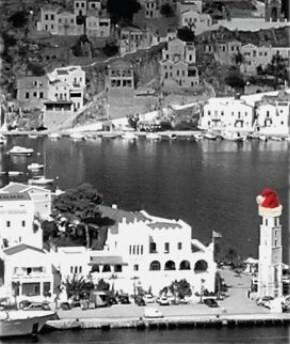 |
Rhodes | Chalki | Tyros | Nisyros | Simi |
   
|
|


